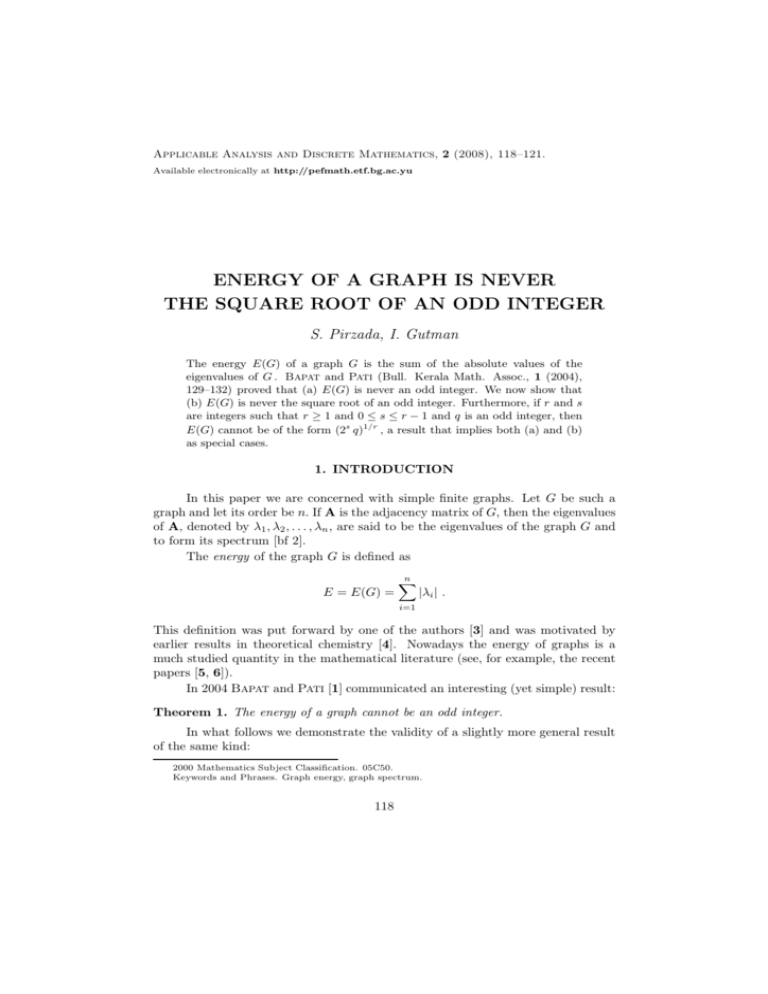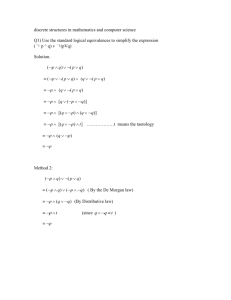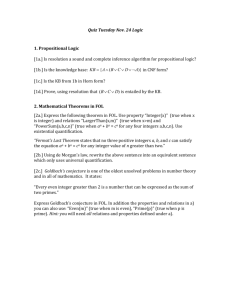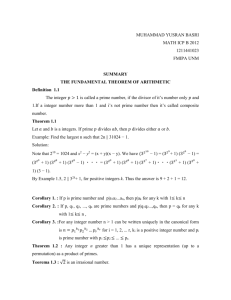energy of a graph is never the square root of an odd integer
advertisement

Applicable Analysis and Discrete Mathematics, 2 (2008), 118–121. Available electronically at http://pefmath.etf.bg.ac.yu ENERGY OF A GRAPH IS NEVER THE SQUARE ROOT OF AN ODD INTEGER S. Pirzada, I. Gutman The energy E(G) of a graph G is the sum of the absolute values of the eigenvalues of G . Bapat and Pati (Bull. Kerala Math. Assoc., 1 (2004), 129–132) proved that (a) E(G) is never an odd integer. We now show that (b) E(G) is never the square root of an odd integer. Furthermore, if r and s are integers such that r ≥ 1 and 0 ≤ s ≤ r − 1 and q is an odd integer, then E(G) cannot be of the form (2s q)1/r , a result that implies both (a) and (b) as special cases. 1. INTRODUCTION In this paper we are concerned with simple finite graphs. Let G be such a graph and let its order be n. If A is the adjacency matrix of G, then the eigenvalues of A, denoted by λ1 , λ2 , . . . , λn , are said to be the eigenvalues of the graph G and to form its spectrum [bf 2]. The energy of the graph G is defined as E = E(G) = n X i=1 |λi | . This definition was put forward by one of the authors [3] and was motivated by earlier results in theoretical chemistry [4]. Nowadays the energy of graphs is a much studied quantity in the mathematical literature (see, for example, the recent papers [5, 6]). In 2004 Bapat and Pati [1] communicated an interesting (yet simple) result: Theorem 1. The energy of a graph cannot be an odd integer. In what follows we demonstrate the validity of a slightly more general result of the same kind: 2000 Mathematics Subject Classification. 05C50. Keywords and Phrases. Graph energy, graph spectrum. 118 Energy of a graph is never the square root of an odd integer 119 Theorem 2. The energy of a graph cannot be the square root of an odd integer. In order to prove Theorem 2 we need some preliminaries. 2. PRELIMINARIES Using the terminology and notation from the book [2], we define two operations with graphs. By V (G) and E(G) are denoted the vertex and edge sets, respectively, of the graph G. Let G1 and G2 be two graphs with disjoint vertex sets of orders n1 and n2 , respectively. The product of G1 and G2 , denoted by G1 × G2 , is the graph with vertex set V (G1 ) × V (G2 ) such that two vertices (x1 , x2 ) ∈ V (G1 × G2 ) and (y1 , y2 ) ∈ V (G1 × G2 ) are adjacent if and only if (x1 , y1 ) ∈ E(G1 ) and (x2 , y2 ) ∈ E(G2 ). The sum of G1 and G2 , denoted by G1 + G2 , is the graph with vertex set V (G1 ) × V (G2 ) such that two vertices (x1 , x2 ) ∈ V (G1 + G2 ) and (y1 , y2 ) ∈ V (G1 + G2 ) are adjacent if and only if either (x1 , y1 ) ∈ E(G1 ) and x2 = y2 or (x2 , y2 ) ∈ E(G2 ) and x1 = y1 . The above specified two graph products have the following spectral properties (see [2], p. 70). (1) (2) Let λi , i = 1, . . . , n1 , and λj , j = 1, . . . , n2 , be, respectively, the eigenvalues of the graphs G1 and G2 . (1) (2) Lemma 1. The eigenvalues of G1 × G2 are λi λj , i = 1, . . . , n1 ; j = 1, . . . , n2 . (1) (2) Lemma 2. The eigenvalues of G1 +G2 are λi +λj , i = 1, . . . , n1 ; j = 1, . . . , n2 . The eigenvalues of a graph are zeros of the characteristic polynomial and the characteristic polynomial is a monic polynomial with integer coefficients. Therefore we have: Lemma 3. If an eigenvalue of a graph is a rational number, then it is an integer. 3. PROOF OF THEOREM 2 Consider a graph G and let λ1 , λ2 , . . . , λm be its positive eigenvalues. Then in view of the fact that the sum of all eigenvalues of any graph is equal to zero E(G) = 2 m X λi . i=1 Denote λ1 + λ2 + · · · + λm by λ. By Lemma 1 λ is an eigenvalue of some graph H isomorphic to the sum of m disjoint copies of the graph G. By Lemma 2 λ2 is an eigenvalues of the product of two disjoint copies of the graph H. 120 S. Pirzada, I. Gutman √ √ Suppose now that E(G) = q, where q is some integer. Then 2 λ = q, i.e., λ2 = q/4. If q would be an odd integer, then q/4 would be a nonintegral rational number in contradiction to Lemma 3. Theorem 2 follows. We have an immediate extension of Theorem 2: Observation. The energy of a graph cannot be the square root of the double of an odd integer. However, this observation is just a special case of a somewhat more general result. 4. GENERALIZING THEOREM 2 Let H be the same graph as in the preceding section. Thus λ an eigenvalue of H. Let H ∗ be the product of r disjoint copies of H. Then by Lemma 2 λr is an eigenvalue H ∗ . Suppose now that E(G) = q 1/r , where q is some integer. Then 2 λ = q 1/r , r i.e., λ = q/2r . If q would not be divisible by 2r , then λr would be a nonintegral rational number in contradiction to Lemma 3. Therefore we have: Theorem 3. Let r and s be integers such that r ≥ 1 and 0 ≤ s ≤ r − 1 and q be 1/r an odd integer. Then E(G) cannot be of the form (2s q) . For r = 1 and s = 0 Theorem 3 reduces to Theorem 1. For r = 2 and s = 0 Theorem 3 reduces to Theorem 2. The Observation pertains to r = 2 and s = 1. REFERENCES 1. R. B. Bapat, S. Pati: Energy of a graph is never an odd integer. Bull. Kerala Math. Assoc., 1 (2004), 129–132. 2. D. Cvetković, M. Doob, H. Sachs: Spectra of Graphs – Theory and Application. Academic Press, New York, 1980; 2nd revised ed.: Barth, Heidelberg, 1995. 3. I. Gutman: The energy of a graph. Ber. Math. Statist. Sekt. Forshungsz. Graz, 103 (1978), 1–22. 4. I. Gutman, O. E. Polansky: Mathematical Concepts in Organic Chemistry. Springer– Verlag, Berlin, 1986. 5. H. Hua, M. Wang: Unicyclic graphs with given number of pendent vertices and minimal energy. Lin. Algebra Appl., 426 (2007), 478–489. 6. V. Nikiforov: Graphs and matrices with maximal energy. J. Math. Anal. Appl., 327 (2007) 735–738. Energy of a graph is never the square root of an odd integer Department of Mathematics, University of Kashmir, Srinagar, India E-mail: sdpirzada@yahoo.co.in Faculty of Science, University of Kragujevac, Kragujevac, Serbia E-mail: gutman@kg.ac.yu 121 (Received October 6, 2007)







